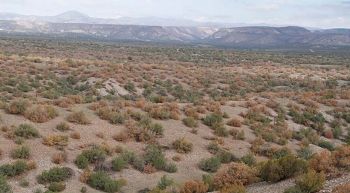Adams et al., 2017
A multi-species synthesis of physiological mechanisms in drought-induced tree mortality
Adams H.D., Zeppel M.J.B., Anderegg W.R.L., Hartmann H., Landhausser S.M., Tissue D.T., Huxman T.E., Hudson P.J., Franz T.E., Allen C.D., Anderegg L.D.L., Barron-Gafford G.A., Beerling D.J., Breshears D.D., Brodribb T.J., Bugmann H., Cobb R.C., Collins A.D., Dickman L.T., Duan H., Ewers B.E., Galiano L., Galvez D.A., Garcia-Forner N., Gaylord M.L., Germino M.J., Gessler A., Hacke U.G., Hakamada R., Hector A., Jenkins M.W., Kane J.M., Kolb T.E., Law D.J., Lewis J.D., Limousin J-M., Love D.M., Macalady A.K., Martinez-Vilalta J., Mencuccini M., Mitchell P.J., Muss J.D., O'Brien M.J., O'Grady A.P., Pangle R.E., Pinkard E.A., Piper F.I., Plaut J.A., Pockman W.T., Quirk J., Reinhardt K., Ripullone F., Ryan M.G., Sala A., Sevanto S., Sperry J.S., Vargas R., Vennetier M., Way D.A., Xu C., Yepez E.A., and McDowell N.G. (2017)
Nature Ecology & Evolution 1: 1285–1291
-
Catalina-Jemez, INVESTIGATOR
-
Catalina-Jemez, INVESTIGATOR
-
Catalina-Jemez, INVESTIGATOR, COLLABORATOR
-
Catalina-Jemez, INVESTIGATOR
Abstract
Widespread tree mortality associated with drought has been observed on all forested continents and global change is expected to exacerbate vegetation vulnerability. Forest mortality has implications for future biosphere–atmosphere interactions of carbon, water and energy balance, and is poorly represented in dynamic vegetation models. Reducing uncertainty requires improved mortality projections founded on robust physiological processes. However, the proposed mechanisms of drought-induced mortality, including hydraulic failure and carbon starvation, are unresolved. A growing number of empirical studies have investigated these mechanisms, but data have not been consistently analysed across species and biomes using a standardized physiological framework. Here, we show that xylem hydraulic failure was ubiquitous across multiple tree taxa at drought-induced mortality. All species assessed had 60% or higher loss of xylem hydraulic conductivity, consistent with proposed theoretical and modelled survival thresholds. We found diverse responses in non-structural carbohydrate reserves at mortality, indicating that evidence supporting carbon starvation was not universal. Reduced non-structural carbohydrates were more common for gymnosperms than angiosperms, associated with xylem hydraulic vulnerability, and may have a role in reducing hydraulic function. Our finding that hydraulic failure at drought-induced mortality was persistent across species indicates that substantial improvement in vegetation modelling can be achieved using thresholds in hydraulic function.
Citation
Adams H.D., Zeppel M.J.B., Anderegg W.R.L., Hartmann H., Landhausser S.M., Tissue D.T., Huxman T.E., Hudson P.J., Franz T.E., Allen C.D., Anderegg L.D.L., Barron-Gafford G.A., Beerling D.J., Breshears D.D., Brodribb T.J., Bugmann H., Cobb R.C., Collins A.D., Dickman L.T., Duan H., Ewers B.E., Galiano L., Galvez D.A., Garcia-Forner N., Gaylord M.L., Germino M.J., Gessler A., Hacke U.G., Hakamada R., Hector A., Jenkins M.W., Kane J.M., Kolb T.E., Law D.J., Lewis J.D., Limousin J-M., Love D.M., Macalady A.K., Martinez-Vilalta J., Mencuccini M., Mitchell P.J., Muss J.D., O'Brien M.J., O'Grady A.P., Pangle R.E., Pinkard E.A., Piper F.I., Plaut J.A., Pockman W.T., Quirk J., Reinhardt K., Ripullone F., Ryan M.G., Sala A., Sevanto S., Sperry J.S., Vargas R., Vennetier M., Way D.A., Xu C., Yepez E.A., and McDowell N.G. (2017): A multi-species synthesis of physiological mechanisms in drought-induced tree mortality. Nature Ecology & Evolution 1: 1285–1291. DOI: 10.1038/s41559-017-0248-x
 This Paper/Book acknowledges NSF CZO grant support.
This Paper/Book acknowledges NSF CZO grant support.
Explore Further




